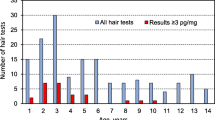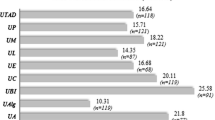Abstract
Considering the widespread nature of alcohol-related problems, the diagnosis of excessive alcohol consumption is an important task from medical and legal viewpoints. Alcohol abuse can be documented by usual blood [e.g., carbohydrate deficient transferrin (CDT)] and liver function [e.g., γ-GT or mean corpuscular volume (MCV)] tests, and, over a long-term basis, by hair analysis. Major markers of ethanol consumption in hair are ethyl glucuronide (EtG) and fatty acid ethyl esters (FAEEs). Detection of EtG in hair is said to be associated with excessive alcohol consumption, whereas a negative result does not unambiguously exclude alcohol abuse. Investigations on FAEEs can also be used to monitor excessive alcohol consumption. Four FAEEs (ethyl myristate, ethyl palmitate, ethyl oleate, and ethyl stearate) are the most suitable markers for the detection of heavy alcohol consumption and show different concentrations in hair of children, adult teetotalers, and social drinkers in comparison with FAEEs concentrations found in the hair of alcoholics. The Society of Hair Testing has provided guidelines for hair testing for chronic excessive alcohol consumption, and states positive cutoffs for a 0–3 cm hair segment as 30 pg/mg and 0.5 ng/mg for EtG and FAEEs, respectively. This study reviews the difficulties in interpreting blood and hair results of a 41-year-old woman involved in a child custody legal dispute. Her EtG and FAEEs concentrations in a 0–3 cm segment were 203 pg/mg and 0.29 ng/mg, respectively, and blood parameters were in the normal range (0.6 %, 93 fl, 14 IU/l for CDT, MCV, and γ-GT, respectively). Although the high EtG concentration suggested excessive drinking behavior, the second hair marker, FAEEs, and the three bloods tests were inconspicuous and in accordance with the claim of abstinence from alcohol by the subject. The woman declared having dyed her hair more than 6 months prior to sampling, use of weight-loss medication, and consumption of about four energy drinks per day. A hair lotion based on ethanolic plant extracts was regularly used by the subject, and could have been a source of contamination. Therefore, we recommend that possible external sources of hair contamination always be taken into consideration, especially if contradictory biological results are obtained and if the subject denies any alcohol intake.
Similar content being viewed by others
References
Wada M, Sugimoto Y, Ikeda R, Isono K, Kuroda N, Nakashima K (2012) Determination of methamphetamine in neonatal hair and meconium samples: estimation of fetal drug abuse during pregnancy. Forensic Toxicol 30:80–83
Kintz P (2012) Hair analysis for doxylamine. Forensic Toxicol 30:173–178
De Castro A, Lendoiro E, Quintela O, Concheiro M, Lopez-Rivadulla M, Cruz A (2012) Hair analysis interpretation of an unusual case of alleged scopolamine-facilitated sexual assault. Forensic Toxicol 30:193–198
Politi L, Morini L, Leone F, Polettini A (2006) Ethyl glucuronide in hair: is it a reliable marker of chronic high levels of alcohol consumption? Addiction 101:1408–1412
Pragst F, Rothe M, Moench B, Hastedt M, Herre S, Simmert D (2010) Combined use of fatty acid ethyl esters and ethyl glucuronide in hair for diagnosis of alcohol abuse: interpretation and advantages. Forensic Sci Int 196:101–110
Pragst F, Yegles M (2006) Alcohol markers in hair. In: Kintz P (ed) Analytical and practical aspects of drug testing in hair. CRC Taylor & Francis, Boca Raton, pp 287–323
Kintz P (2012) Consensus of the society of hair testing on hair testing for chronic excessive consumption 2011. Forensic Sci Int 218:2
Suesse S, Pragst F, Mieczowski T, Selavka CM, Elian A, Sachs H, Hastedt M, Rothe M, Campbell J (2012) Practical experiences in application of hair fatty acid ethyl esters and ethyl glucuronide for detection of chronic alcohol abuse in forensic cases. Forensic Sci Int 218:82–91
Hastedt M, Herre S, Pragst F, Rothe M, Hartwig S (2012) Workplace alcohol testing program by combined use of ethyl glucuronide and fatty acid ethyl esters in hair. Alcohol Alcohol 47:127–132
Kintz P (2013) Interprétation des marqueurs de l’éthanol dans les cheveux (EtG et FAEE) en regard des paramètres sanguins usuels et de leurs fenêtres de détection. Rev Med Leg (in press)
Liniger B, Nguyen A, Friedrich-Koch A, Yegles M (2010) Abstinence monitoring of suspected drinking drivers: ethyl glucuronide in hair versus CDT. Traffic Inj Prev 11:123–126
Tagliaro F, Bortolotti F, Viel G, Ferrara SD (2011) Caveats against an improper use of hair testing to support the diagnosis of chronic excessive alcohol consumption, following the “Consensus” of the Society of Hair Testing 2009. Forensic Sci Int 207:1–3
Kintz P, Villain M, Vallet E, Etter M, Salquebre G, Cirimele V (2008) Ethyl glucuronide: unusual distribution between head hair and pubic hair. Forensic Sci Int 176:87–90
Pragst F, Auwaerter V, Sporkert F, Spiegel K (2001) Analysis of fatty acid ethyl esters in hair as possible markers of chronically elevated alcohol consumption by headspace solid-phase microextraction (HS-SPME) and gas chromatography mass spectrometry (GC–MS). Forensic Sci Int 121:76–88
Martins L, Bint T, Yegles M (2011) Influence of ethanol containing cosmetics on ethyl glucuronide concentration in hair. Ann Toxicol Anal 23:S1–S10
Sporkert F, Kharbouche H, Augsburger MP, Klemm C, Baumgartner MR (2012) Positive EtG findings in hair as a result of a cosmetic treatment. Forensic Sci Int 218:97–100
Arndt T, Schröefel S, Stemmerich K (2013) Nachweis von Ethylglucuronid (EtG) in einem Haarwasser. Toxichem Krimtech 80:157–159
Hastedt M, Büchner M, Rothe M, Gapert R, Herre S, Krumbiegel F, Tsokos M, Kienast T, Heinz A, Hartwig S (2013) Detecting alcohol abuse: traditional blood alcohol markers compared to ethyl glucuronide (EtG) end fatty acid ethyl esters (FAEEs) measurement in hair. Forensic Sci Med Pathol (in press)
Albermann ME, Musshoff F, Madea B (2011) Comparison of ethyl glucuronide (EtG) and fatty acid ethyl esters (FAEEs) concentrations in hair for testing abstinence. Anal Bioanal Chem 400:175–181
Author information
Authors and Affiliations
Corresponding author
Rights and permissions
About this article
Cite this article
Kintz, P., Nicholson, D. Interpretation of a highly positive ethyl glucuronide result together with negative fatty acid ethyl esters result in hair and negative blood results. Forensic Toxicol 32, 176–179 (2014). https://doi.org/10.1007/s11419-013-0209-2
Received:
Accepted:
Published:
Issue Date:
DOI: https://doi.org/10.1007/s11419-013-0209-2




